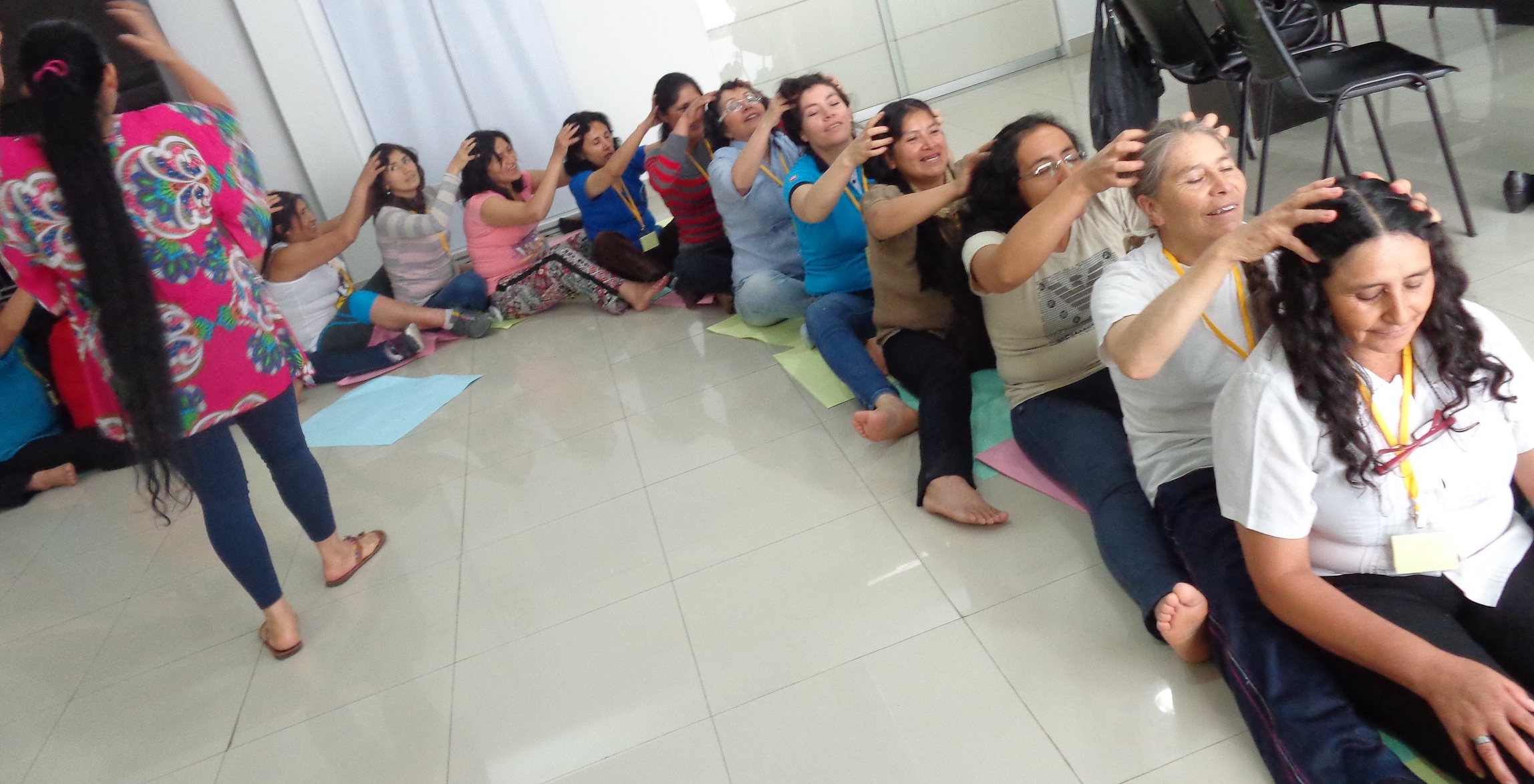
Who is this Manual for?
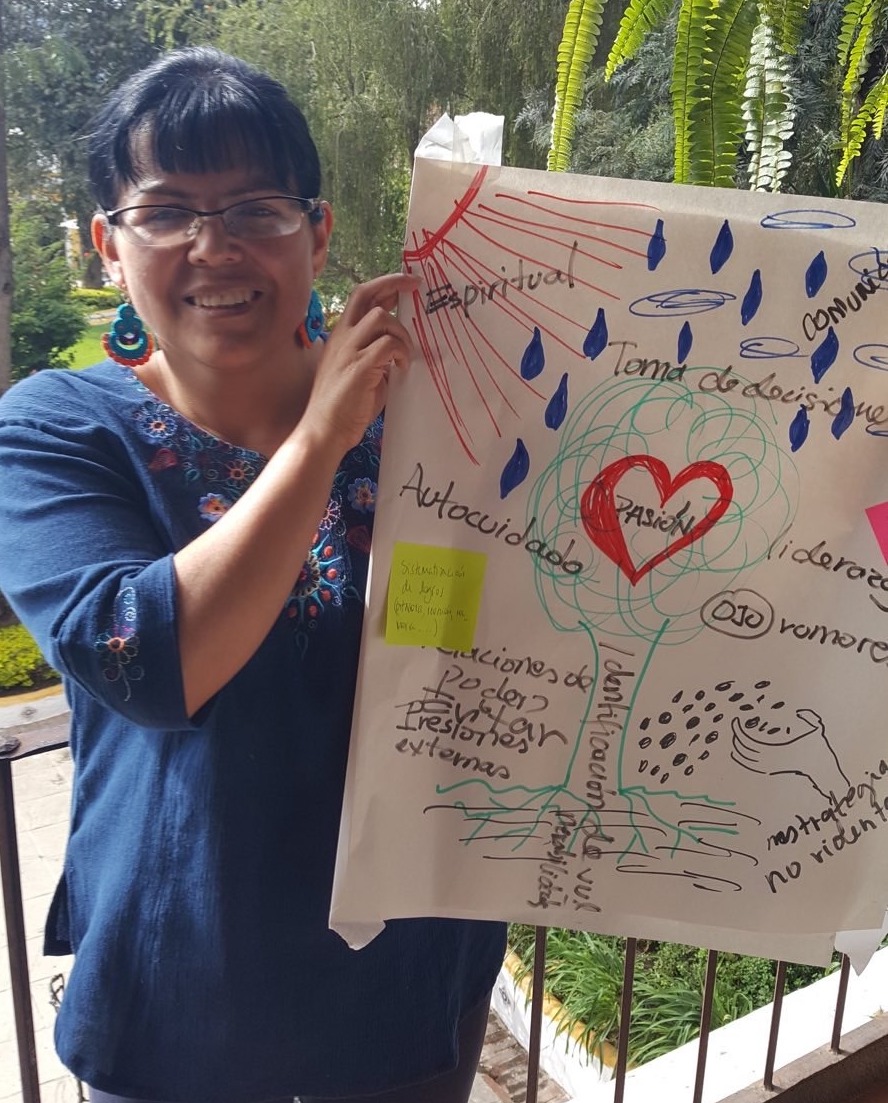 This is an updated edition of Front Line Defenders Trainers’ Manual for those training HRDs at risk.
This is an updated edition of Front Line Defenders Trainers’ Manual for those training HRDs at risk.
The Manual is primarily intended for HRDs trained by Front Line Defenders who are facilitating workshops themselves, sometimes at the request of, and with the support of Front Line Defenders.
It should also be of use and interest to any facilitator working with HRDs at risk.
WHRD Lina Solano demonstrates methodology working with rural communities
Principles of RAPP Training
Front Line Defenders facilitates workshops on Risk Analysis and Protection Planning (RAPP) because this has been a key request from defenders – that they be assisted to develop skills to mitigate risks and threats, and enhance their own protection.
The risk analysis workshops reflect Front Line Defenders values:
Inclusivity: We focus on the primacy and centrality of HRDs, we seek to be inclusive at all times, demonstrating profound respect and empathy for HRDs in all their diversity.
* As facilitators these values should be reflected in the diversity of defenders attending workshops, and the methodology which encourages and promotes space for all contributions, being especially sensitive to intersectional identity.
Agility: We strive to meet the needs expressed by human rights defenders in a fast, flexible and relevant manner.
* As facilitators, we need to be responsive to participants’ needs through Learning Needs Assessment, and discussions. The facilitation team should include at least one facilitator with linguistic and local connections to the participants, in order to advise on the relevancy of methodology and logistics. We need to conduct meaningful risk analysis for the workshop in order to have flexible contingency plans.
Solidarity: We believe in the importance of solidarity. We commit to being present in a meaningful way when HRDs are most at risk; steadfast and relentless in our actions.
* We explain all Front Line Defenders programmes which defenders may engage with - in particular the role of our Protection Coordinators in assisting in case of threats, our Digital Protection Coordinators and our Grants Programme - which are always available. We follow up with participants as groups and one-to-one after the training and are ready to connect with them months or years later.
Integrity: We perform with dedication, professionalism and accountability, acting with independence and integrity at all times.
* While we are part of the group, we also have the duty to be objective and impartial in our methodologies and engagement with the participants.
In addition, we have the added principle of:
Do No Harm
* As facilitators and organisers we must familiarise ourselves with the context and the background of the participants. Holding the workshop should be low risk, and the methodologies and contents should be carefully curated and clearly communicated so that participants can make choices about how much to share, what to do if they feel painful memories are being triggered, and what support is available (ideally a professional therapist should be in the facilitation team or on hand).
Our training is based on the principles of popular education, that the facilitator and the defenders learn together, starting with the experience of defenders, adding new tools and other inputs, reflection and application of the tools and then putting them into practice
This approach is used not only because it is egalitarian, but because it is effective. When defenders are actively engaged, they will learn more and be able to apply new insights to their situation.
Facilitators must be keen to learn too, as every workshop improves our knowledge and skills for dealing with both the content and the process.
I hear and I forget. I see and I remember. I do and I understand.
- Confucius
We also consider principles of Andragogy meaning "the art and science of helping adults learn”, including:
- Need to Know: Adults need to know why they are at this training. For facilitators, that means that participants should be chosen wisely, and the objectives clearly shared in advance.
- Experience: Adults need to draw upon their experiences to for their learning. Facilitators must encourage and draw out the sharing of the defenders’ experience, and also create new experiential learning.
- Self Concept: Adults needs to be responsible for their decisions on education, engaged in the planning, process and evaluation of their learning. As facilitators we need to conduct Learning Needs Analysis and ensure participation and daily evaluations.
- Readiness: Adults need to want to engage with the topic at this time. Participating HRDs should themselves respond positively to invitations, and not only be referred by others.
- Application: Adults want to apply the knowledge they gain in problem solving to their own situations. Facilitators will guide the process to relate to each HRD’s context.
As facilitators we put all these principles into practice during our workshops.
Risk Analysis Training & COVID
The update of this Facilitation Manual began in 2019 and was over-ridden by the pandemic. During 2020 Front Line Defenders developed online workshops customised for different groups of HRDs.
The principle of Do No Harm continues to be uppermost in the planning of in-person workshops, including the following precautions suitable at different times:
- strict considering of whether the training can take place online or not
- constantly checking the infection rate of the country/region/locality/target group, and being prepared to postpone at the last moment if the situation deteriorates
- smaller workshops number
- advising participants about Covid symptoms
- checking with participants that they are comfortable accepting the restrictions
- wearing of masks when interacting
- sessions outside as far as possible, if security and climatic considerations allow
- social distancing as prescribed by the World Health Organisation (WHO)
- a polymerase chain reaction (PCR) test for all before attending the workshop, during (if the workshop is longer than 3 days) and after the workshop
- follow up with all participating for 14 days after the workshop to identify any health issues
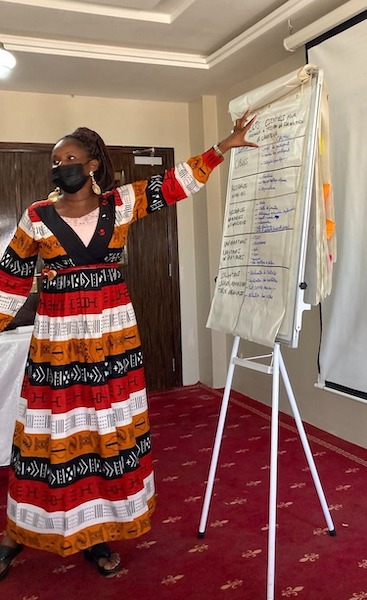
Due to the unpredictability of the COVID-19 virus, these safety measures above cannot be assumed to be relevant in the long-term. They are best practice as far as we can assess in August 2021.
Facilitators, Experts & Training
Content Preparation & Follow Up
The workshop may be a request from HRDs or a priority discussed with colleagues. The participants may be from different organisations or work closely together. Despite the starting point, the steps will be very similar:
- Agree with the initiators the digital platforms you will use to discuss the training
- Initial conversation with the initiators to discuss risks, threats and needs, plus discussion of the facilitation team membership.
- Assembly of the facilitation team, ideally including two risk analysis facilitators, digital protection and psychosocial expert. Depending on risks and threats faced, other experts eg legal, may be appropriate.
- If possible and appropriate ask participants to open more secure channel of communicaon (eg install separate Wire or Signal apps or separate account on Tutanota or Protonmail) and create a group to communicate before, during and after the training process. Send out a registration format asking about contact details, special needs including for disabilities, risks faced and expectations. Note: there are many situations where creating group communication with all participants is not recommended. Also using secure communication tools in some countries may not be safe. Consult with the digital protection trainer or other expert.
- Conduct a Learning Needs Analysis
When working with HRDs with disabilities, do not exclude them or make them feel different. Pay attention so they have access to services and any support they want.
with the participants, discuss the results with the facilitation team and feed them into the programme development. Consider intersectionality, including disability in the programme design.
- Send the draft programme to the participants for comment. Consider the responses, revise and re-send.
- Send reading and preparation exercises to the participants in order to assist them to understand the subject matter more deeply at the training. These could include chapters from the Workbook on Security or Security-in-a-Box
- At the training, have a daily evaluation. Be curious about how to improve the experience for this group. Make changes as proposed if at all possible in order to fully respond to the needs expressed. NB: participants are usually more open about their needs if they discuss them in small groups, rather than in the whole group.
- After the training, follow up with participants regularly, particularly to support them on pledges to create organisation protection plans. There are sample evaluation forms for the end of the workshop and 6 weeks later when you should expect steps to have been taken to create the organisation protection plan.
Best Practice for Working with Experts:
- invite the experts for the whole of the training if possible
- introduce the experts to the participants in advance and explain their roles and any options for individual and/or group sessions
- reflect the holistic nature of the training by involving the experts in the needs assessment to better respond to the group, context and issues
- share the HRDs background, risks contexts, draft agenda and trainers notes with the team, inviting all to discuss and improve the agenda and flow of the training
- if possible and appropriate aim for integrating the expert areas horizontally throughout the training instead creating only one session
- ideally have spaces of otherwise free time for participants to have one to one connections, or parallel small groups with digital or psychosocial experts. Do not rely only on the lunch time and evening possibilities for these interactions.
CHOICE OF PARTICIPANTS
Sometimes the participants are already chosen, eg members of a community. Sometimes there is the opportunity to recommend criteria for choosing participants. Some considerations include:
- Especially vulnerable HRDs: do you have the opportunity to focus on, or include WHRD, Indigenous HRDs, LGBTIQ+ HRDs or Migrant/Refugee HRDs? As HRDs in capital cities usually have most access to capacity building opportunities, can HRDs from rural areas be included?
- Which HRDs face the highest risks? This might be those working on Land/Environment/Indigenous issues or Trans or disabled HRDs.
- If HRDs are in a personal or organisational crisis due to risks, it is not a good time for them to be in a workshop – they require individual, specialised support.
- If HRDs do not face risks in the immediate to mid-term future, the workshops are not suitable for them.
- Sometimes donors, from the best of intentions, insist that their partners are trained on Risk Analysis and Protection Planning. In this case the facilitators will have to consider how to build consensus about the need for the training. It is preferable to have participants who have self-selected to come to a workshop because they need it and they want to learn.
If invitations are being sent out, create Criteria, eg:
- Active HRD
- Facing risks
- Keen to develop skills in Risk Analysis
- In a position to create or improve a protection plan in their organisation
- Not previously experienced structured training on Risk Analysis and Protection Planning
An application process can help decide who will be offered the opportunities. This is the time to ensure that there are more women than men at the workshop (a 3:2 ration works well) in order to maximise the participation of women.
An application should also give HRDs with disabilities the opportunity to identify the support they will need at the workshop.
A pre-vetting process, with a reference from a known local HRD, and a scan of social media should take place to avoid including participants who do not fit the criteria, or are undesirable for other reasons, eg they have been accused of sexual harassment.

Facilitator’s Protection Plan
Protection begins with yourself, so consider before commencing preparations if it is safe and secure for you to be at this workshop.
Facilitators’ initial protection plan example:
| RISK LEVEL | MEASURES TO REDUCE RISK REQUIRED? | |
|---|---|---|
| Location and venue of training | Medium | Choose safest options, such as venue well-known to organiser / allies; strict ban on social media posts |
| Your profile at the location | Low | Consider a cover story which is close to the truth |
| Travel to and from the venue | Medium | Discuss safest means with organiser |
Your profile is not the way you see yourself, it is the way others view you from the outside.
VENUE CHOICE
The venue should relate to the risk situation, the identities and needs of participants and the requirement to ensure the training is in a safe space. Here are some considerations and best practices:
When choosing the venue, as well as the risks, general location, size and cost, consider:
- Some HRDs may have experienced personal trauma or a build up of stress due to their work – you need to create a safe space so that they can relax in order to contribute and learn
- Accessibility for differently-abled participants:
- ask a local partner to go and check that a wheelchair can access the meeting room, accommodation, toilets, dining room etc, as venues may not have considered access from the user’s viewpoint
- consider needs relating to other disabilities, eg hearing-impaired participants will benefit from lighter rooms for lip reading, and more use of slides - Who will the participants be? If there will be LGBTIQ+ participants, a venue known to be sensitive and welcoming should be chosen
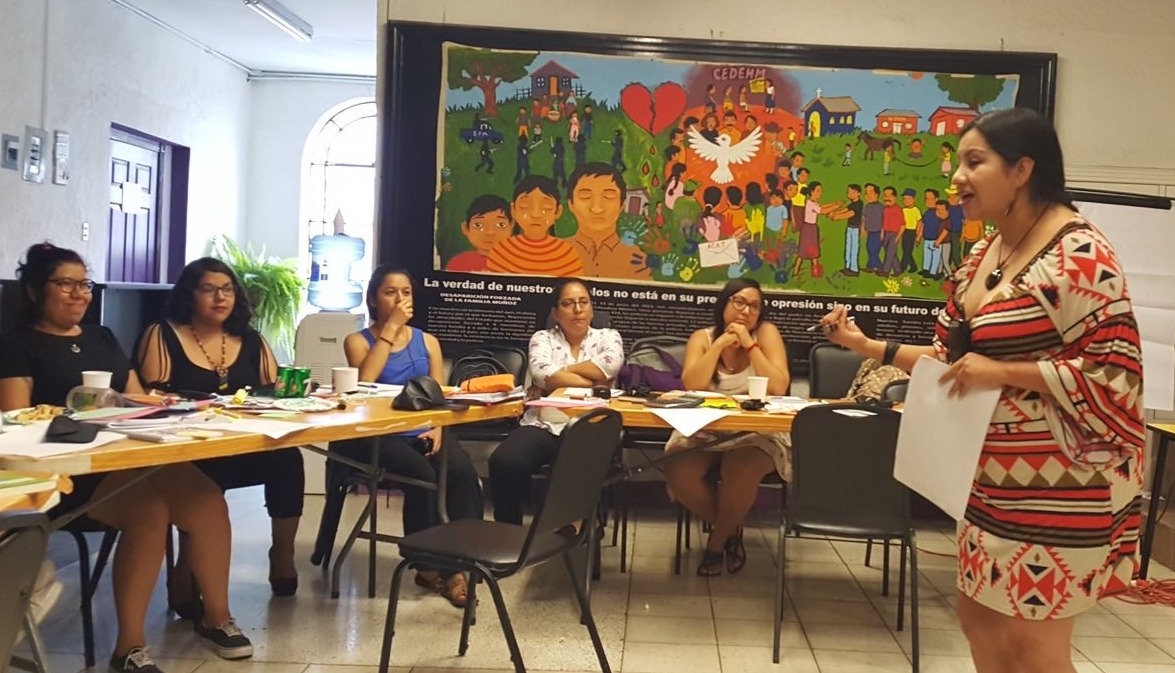
- Who owns the hotel, and who frequents it? A hotel often used by NGOs with sympathetic owners and staff is preferable
- 5-star hotels will generally have listening devices in some of the rooms, staff may report to state intelligence
- If your training is sensitive, consider participants staying in different accommodation (not all together) and have the training venue in the meeting room of a friendly NGO
- If your training is extremely sensitive, have a small group stay in a rented house / AirBnB (booked by a suitable person) and train in the kitchen/dining room. This avoids the necessity to produce IDs or passports in a hotel, and there will be no documented evidence of the group staying together.
COMMUNICATION IN ADVANCE WITH PARTICIPANTS
- Find the safest way to communicate with participants, eg requesting them to install and use an encrypted messenger app, and email
- Check if they have any needs, eg childcare for their baby, requirements related to disability
- Check if they need a protection plan for travel to this workshop, and organise a suitable person to create it with them
- Send Learning Needs Analysis with deadline
- Share the objectives and draft programme and ask for feedback and inputs
- Share the details of the facilitation team, and when/if they are available for individual consultation
- Clarify all logistics arrangements – including if per diem are included – in advance
- Send reading, eg the Security Workbook in advance (but do not expect all participants to have read everything on arrival!)
- Send written assignments for completion and give personal feedback
Example protection plan created with LGBTIQ+ HRD
|
Risks |
Risk |
Mitigation |
|---|---|---|
| Harassment on public transport on way to airport |
Likelihood High Impact Medium-High |
Organisers will pay for personal taxi |
|
Harassment by airport officials when ID does not match appearance |
Likelihood Medium Impact Medium-Low |
HRD will arrive early, in preparation for delays Keep calm and have prepared response Contact Workshop Security Manager or organiser before and after going through immigration |
|
Fear of harassment at venue |
Likelihood low Impact Medium-High |
Single room confirmed Organiser will meet participant at arrival Workshop Security Manager details shared for immediate contact Buddy scheme amongst participants Safeguarding contract with participants Hotel Security Manager contacted and briefed (if appropriate) |
TRANSPORT TO THE VENUE
- To reduce uncertainty and anxiety for participants if the location is in an unknown place to them, arrange every step of the way and send information clearly in advance (or if for security reasons you will communicate the venue at the last minute, give the basic information and the date you will send the exact details)
- If taxis or hired vehicles are used, note that drivers are often government informers, and hired vehicles may be bugged – advise participants to have neutral conversations
- If the venue is to be kept secret, until the last moment participants may be picked up by bus and driven there (this is a technique to be used where there is strong trust between the organisers and participants, otherwise it could cause anxiety)
CHECKING THE VENUE ON ARRIVAL
- Be the first person to arrive at the venue and the last one to leave, to deal with any complications
- When you arrive, ask for the name and contact details of the venue staff person who will be your main contact. Check also if there is a security manager and introduce yourself if appropriate
- Check access for participants with disabilities to their rooms, the training room, toilets and dining area
- Go to the training space/s and ask for any adjustments:
- have a good look round and open any doors to check what is there
- ensure the training space is relaxed and appropriate for the participants
- request the venue to remove any formal set up with tablecloths and tables separating the facilitators from the participants as these reinforce power dynamics
- consider the most appropriate seating arrangement for the participants
- what is the culture of participants in seating arrangements? Are there any mats or cushions available for participants to sit on the floor or lie down?
- a circle of chairs is the most egalitarian set-up with tables for group work in a separate space
- ‘cafe style’ set-up (eg 4 participants round each of a number of small tables) is excellent for team building
- ask what additional space you can use including outside eg for group work and well-being sessions (consider security of conversations)
- always insist on coffee/tea breaks being catered outside your training room to avoid disturbance (and overhearing) - Ensure that any signage used by the venue uses the wording you have specified (eg you may not want your organisation’s name, or the words ‘Risk Analysis’ used, but prefer a more general sign such as ‘Capacity Building’)
- Check whereabouts of the toilets, fire extinguishers and emergency exits and communicate this to participants before the training
- If the participants are LGBTIQ+ HRDs, it may be wise to tell the venue reception staff that they should deal sensitively with the situation that some participants may look very different to their ID documents
TIP: If you have taken the tables away, and participants request them, ask for the agreement of participants to try one day without tables. Or set up a table only for those who need it
MEETING THE PARTICIPANTS AT THE VENUE
* Be in reception to welcome the participants on arrival
* Remind them about any prohibition on social media, and not to take any photos without permission
* Accompany any participants with disabilities to their rooms, the dining area, toilets and the training room to check all is accessible, and ask what support would be helpful
At a meeting of activists from the Middle East, state agents attempted to infiltrate the venue and take a photo of the attendance list on the registration table
* Organise a welcome briefing, including at least the following:
- the security situation in the venue and surroundings, and any precautions to be taken. This may include a recommendation not to go out alone. Balance the risk with the autonomy of the HRDs and consider how well they know the area/culture/risks, and intersectional aspects eg gender identity or ethnic identity which could give them a higher risk profile
- security incidents: in case of any kind of security incident, participants should contact the Workshop Security Manager (it may be you) - give phone number and room number
- check you have an up-to-date list of each participants' number, and note if they have internet outside of the venue or not
- for HRDs possibly facing higher risks, eg LGBTIQ+ HRDs in some locations, consider a buddy system so if anyone goes out, they inform their buddy where they are going and what time they will return
- what to do if they have a problem (eg accommodation, health etc)
- distribute per diem if appropriate
- overview of arrangements for meals and breaks, in particular the next meal
- programme, with timings, including any recreational activities
- keep a list of room numbers, and tell participants your own room number
- If you must use an attendance list (because you don’t know who the participants are / there are a lot of participants / the donors or auditors demand it) ensure it remains with you at all times
SECURITY CONSIDERATIONS DURING THE TRAINING
- Remind participants not to leave laptops or notebooks in the training room even if you have the key (so does the venue!)
- Remind participants that leaving laptops or other valuables in the hotel safe is not 100% secure as the venue staff have access
- If there are flipcharts, be responsible for what is visible (including during breaks), and dispose of any sensitive sheets securely during and at the end of the workshop
- Depending on the venue and location, participants may be asked not to discuss the training in public areas, taxis, restaurants etc
SECURITY CONSIDERATIONS AT THE END OF THE TRAINING
- On the last training day, remind participants about their protection plans to travel to and from the workshop and to keep any cover story clear, with photo ‘evidence’ eg of ‘tourism’ if needed
- If there are handouts or certificates at the workshop, discuss if these might be risky for some or all participants to keep
DEALING WITH CHALLENGING SITUATIONS
As a facilitator you will always meet new challenges with each group, and your wisdom will grow as you deal with them. HRDs have often personally experienced events and threats which have impacted them, and recalling them, or hearing similar experiences can trigger strong responses.
Having a co-facilitator with a background which is similar to that of the participants will be a good capacity, as they can advise you about cultural norms, and you can consider which of you will be better equipped, due to identity or experience, to handle challenging topics. For example, a woman facilitator should work separately with WHRDs if sexual violence is discussed.
Engaging a psychotherapist for the workshop is best practice. They may be able to assist with difficult situations, and can facilitate sessions on well-being as well as offer individuals or small groups sessions outside of your programme. A local therapist known to the group is preferred, for trust issues and long-term support.
Here are a few of the challenges in group dynamics and responses from impacted HRDs faced by facilitators using this manual, and their suggestions for dealing with them.
GROUP DYNAMIC CHALLENGES
| Possible Reasons | Some Solutions | |
|---|---|---|
|
Silence when you ask for contributions |
Lack of understanding of the question |
Rephrase or reframe in a simpler way |
|
Tip: privately ask the co-facilitator or some of the participants why they think there is silence |
Not knowing the answer |
Split into groups, so that those who don’t know can learn from those who do |
|
Tip: participant selection has not been good – improve it next time |
Not being interested in the topic because they are not facing risks |
* Ask participants facing risks to share them to educate others * Remind everyone of the different elements of the programme and the end results * Review the agenda and prioritise those sessions everyone should have an interest in, eg well-being and digital protection * Increase the participatory methodologies, eg role play |
|
Tip: room layout, eg a circle, helps develop a sense of equality. Check with the quieter participants separately if there is any block to participation. When inviting participants, invite more WHRDs than MHRDs. |
Being too shy to speak in the main group Intimidated by more experienced HRDs or by more talkative or assertive participants |
* Ensure that from the beginning everyone says something short * Accept some participants may want to listen more than others * Use ice-breakers frequently * Have regular group work and ask for someone different each time to report back * Emphasise that less experienced HRDs often have fresh solutions to contribute * If there is a gender divide (eg WHRDs do not speak), name what is happening and only take contributions from women for a while * If the WHRDs are very quiet, have a session only with the WHRDs about their experience as WHRDs; encourage them to speak out * If there is a gender divide, integrate this into the workshop and have some sessions only for women or men (eg security in the home or workplace) and use the differences in reports as discussion points about holistic protection |
| Participants are tired |
* You may have gone too long without a participatory activity or a break * Have a ‘buzz group’ of 2 or 3 people on a simple question. You will hear the sound in the room increase quickly! Then ask for feedback on the most interesting points * Ask how energised participants are feeling on a scale of 1-5 (where 5 is high energy. Each person should show this by holding up one hand and showing their thumb plus number of fingers. If the energy is low, take a break |
|
|
Domination of discussion by one or more participants |
The defender/s are more experienced |
* If the HRD is more experienced, ask them to give a short presentation, or facilitate a session based on their experience, so they will feel acknowledged |
|
Tip: Group ground rules set at the beginning of the workshop should assist in advance. Ask those who know they talk too much to step back, and those who know they are generally quieter to step forward more |
* Speak to them privately, acknowledge their experience and ask for their help in encouraging quieter defenders to speak |
|
|
* Change your methodologies to participatory sessions where each is invited to speak for the same period of time |
||
|
* When facilitating, don’t give automatic space to the person who wants to speak the most, but say (eg) “let’s hear from those who haven’t spoken yet” or “let’s have some views from WHRDs now” |
PARTICIPANTS AFFECTED BY THE SUBJECT MATTER
Talking about risks and threats has a strong emotional impact. HRDs may be triggered by recounting their own experience or hearing about the experience of others.
Discussing risks and threats will create anxiety and fear for many HRDs. Even though they are safe in the training venue, part of the brain responds to discussion of concepts of danger in the same way it responds to danger, as explained in this insightful article by Craig Higson-Smith:
Leaving the room, initiating side-chats, not engaging, or actively challenging the facilitator can be responses to this feeling of fear. Facilitators should focus on the positive impact of protection plans, engage individually with participants as far as possible, and recognise the signs and symptoms of impacted defenders.
Crying:
- in some cultures and contexts, it may be normal for participants to cry when talking about their experience or hearing about an experience from another HRD
- as the facilitator, your role is to create a safe space, where participants may cry if they wish to, and feel supported
- offer the participant some tissues and water if appropriate, and show your acceptance by body language (eg moving closer, sitting down, facial expression) acknowledging what has been said in some way, eg “I’m so sorry you experienced that”
- ask what did you do (factual, short)? Not how did you feel? (which opens it up)
- let them finish the story, and then move on
- allow the person to cry without trying to stop them
- if the person leaves the room, and you cannot, suggest someone they are close to goes to check on them, and later check with them yourself, asking how they are feeling now
Suspicion of others:
In a reflection of the opponents’ tactics of dividing the human rights movement, some HRDs may be suspicious of others:
- where government informers regularly infiltrate human rights organisations, or are imposed upon them, HRDs may become suspicious of others they don’t know. Your pre-interview vetting should have identified any problems. If not, use your local contacts to check out the veracity of the concern. If the result is that the person is a known government informer, and a number of participants are concerned about their security as a result, you may decide to ask the accused person to leave. If it is unclear - which is more likely - you may decide to make a statement saying that even if some participants have contact with (eg) government, the workshop is not a secret, the content is not illegal, the general strategies and tactics are not dangerous if known, however HRDs should not feel obliged to share details they prefer not to reveal.
- where HRDs may prefer to keep their work secret (eg LGBTIQ+ HRDs in repressive situations, and HRDs uncovering responsibility for government violations), do not pressure anyone to be public. Offer one-to-one sessions to these HRDs so they can share with you aspects of their protection planning that they feel unable to share in the group.
Suicidal thoughts:
- In the safe space you have created, an HRD may tell you, possibly confidentially, that they have been feeling suicidal or attempted suicide recently.
- Discuss with them how they are feeling now, and what support they would like. Give them your number (or that of another relevant person at the workshop) so they can ring at any time.
- It is more likely they will commit suicide if they have a history of attempts, and have a specific plan for how to do it.
- If you believe the participant is likely to attempt suicide, it is legitimate to break confidentiality and contact the relevant NGO or local health facility which can assist.
- Nevertheless, the experiences of facilitators who have experienced this situation have been that the HRDs began to feel stronger and more empowered during the workshop.

CREATING THE PROGRAMME
There are many hours of modules contained in this Facilitation Manual. Facilitators should choose the most appropriate for the needs expressed by the participants.
Workshops work best with between 12-15 participants in order to have sufficient time for each person to engage, speak and be heard.
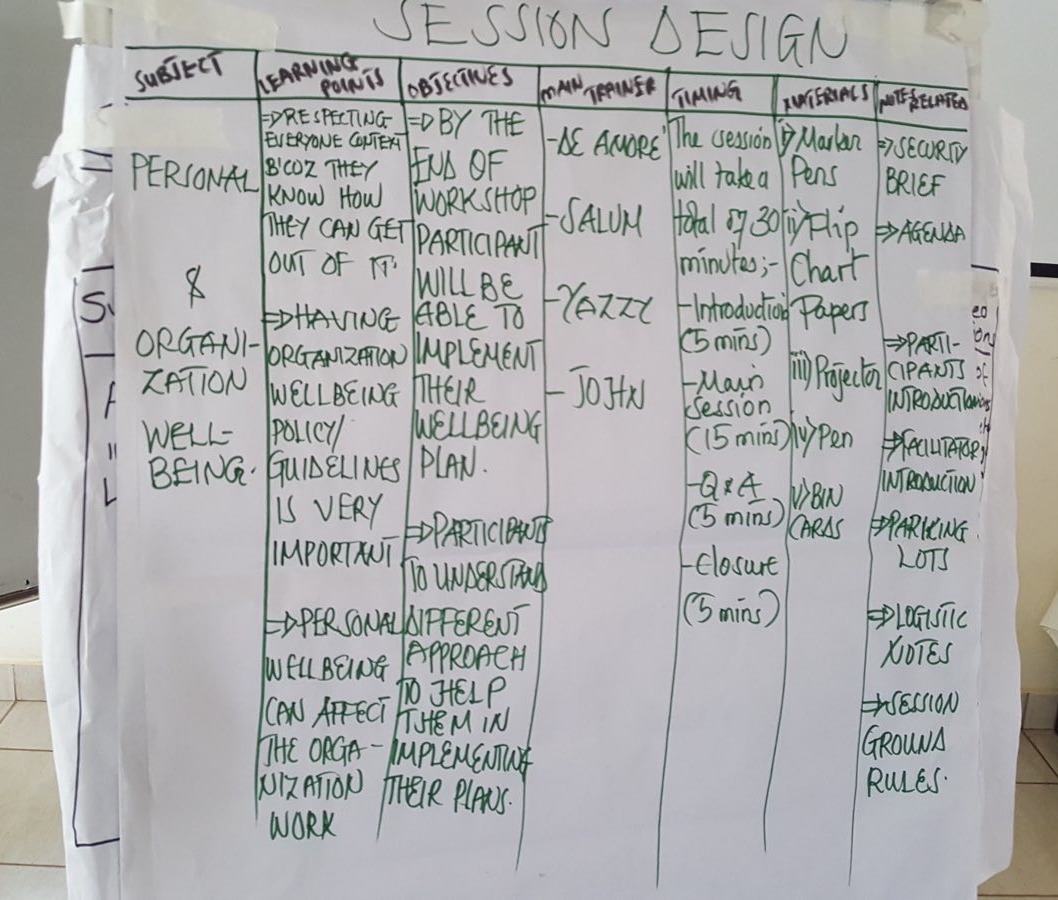 Energisers, breaks and lunchtime are essential.
Energisers, breaks and lunchtime are essential.
Adults learn best when they are well-rested and not overwhelmed by too much information, so formal sessions totalling approximately 360 minutes (6 hours) plus energisers and breaks works best.
Begin the programme planning by considering the needs expressed by the participants, and the advice of your co-facilitators and experts.
Considerations of intersectionality are essential at this stage, eg:
- the pattern of discrimination against LGBTIQ HRDs mean they may take longer to develop a relationship of trust with new people, so add in more introductory exercises and group work to build trust
- Indigenous HRDs may prefer a longer story-telling approach to some situations, rather than a shorter brainstorm
- if you don’t have enough time, cover less topics rather than squeeze each one
- allocate assignments or reading before or after the workshop to deepen learning, and send videos, if appropriate, about key issues to prepare participants
